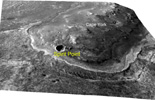
|
Opportunity’s First Goal at Endeavour Crater: ‘Spirit Point’
- Click the image above for a larger view
- Full-Res JPEG (8192 x 5789) (3.5 MB)
- Full-Res TIFF (8192 x 5789) (47.5 MB)
Caption:

Annotated Image
Click on the image for larger version
This oblique view with moderate vertical exaggeration shows the portion of the rim of Endeavour crater given the informal name "Spirit Point." This is the location where the team operating NASA's Mars Exploration Rover Opportunity plans to drive the rover to its arrival at the Endeavour rim.
Endeavour crater has been the rover team's destination for Opportunity since the rover finished exploring Victoria crater in August 2008. Endeavour, with a diameter of about 14 miles (22 kilometers), offers access to older geological deposits than any Opportunity has seen before. The western rim of Endeavour has a series of ridges. Spirit Point is the southern edge of a ridge called "Cape York."
This view, as if looking toward the north from an aircraft over the western edge of Endeavour, was created from computer modeling based on a stereo pair of images taken by the High Resolution Imaging Science Experiment (HiRISE) camera on NASA's Mars Reconnaissance Orbiter. The vertical dimension is exaggerated three-fold, compared to horizontal dimensions. For scale, the Cape York ridge is about 400 feet (about 120 meters) across. Between this ridge and the next ridge segment of the rim to the south lies a gap informally named "Botany Bay."
Background Info:
Opportunity and its twin, Spirit, completed their three-month prime missions in April 2004 and continued operations in bonus extended missions. Spirit stopped communicating in March 2010 as energy available to the rover declined. Calling Opportunity's first Endeavour contact site Spirit Point honors the accomplishments of the Spirit mission. The Mars Reconnaissance Orbiter reached Mars in 2006, completed its prime mission in 2010, and is also working in an extended mission. NASA's Jet Propulsion Laboratory, a division of the California Institute of Technology in Pasadena, manages the Mars Exploration Rover Project and the Mars Reconnaissance Orbiter for the NASA Science Mission Directorate, Washington. The University of Arizona, Tucson, operates the orbiter's HiRISE camera, which was built by Ball Aerospace & Technologies Corp., Boulder, Colo.
Cataloging Keywords:
| Name | Value | Additional Values |
|---|---|---|
| Target | Mars | |
| System | ||
| Target Type | Planet | |
| Mission | Mars Exploration Rover (MER) | Mars Reconnaissance Orbiter (MRO) |
| Instrument Host | Mars Reconnaissance Orbiter | Opportunity (MER-B), Spirit (MER-A) |
| Host Type | Orbiter | Rover |
| Instrument | High Resolution Imaging Science Experiment (HiRISE) | |
| Detector | ||
| Extra Keywords | Color, Crater | |
| Acquisition Date | ||
| Release Date | 2011-06-08 | |
| Date in Caption | ||
| Image Credit | NASA/JPL-Caltech/Univ. of Arizona | |
| Source | photojournal.jpl.nasa.gov/catalog/PIA14134 | |
| Identifier | PIA14134 | |
